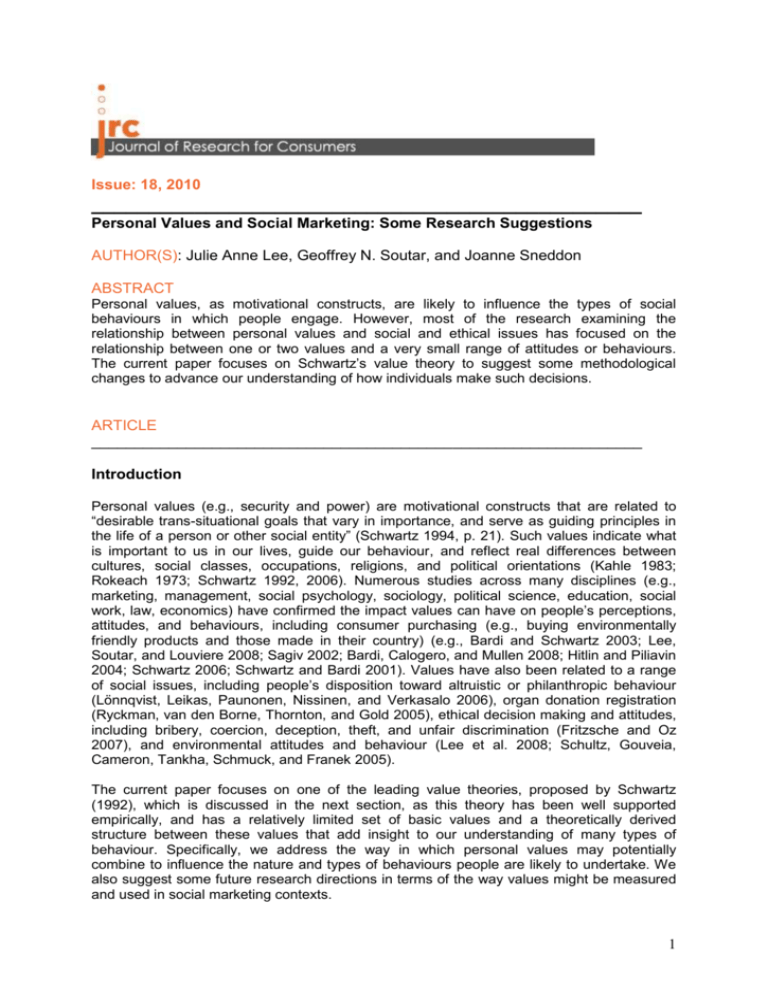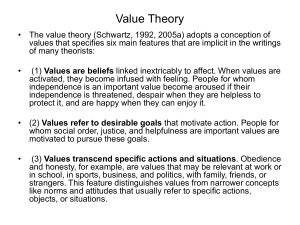c1 project description (10 a4 page maximum)
advertisement

Issue: 18, 2010 ________________________________________________ Personal Values and Social Marketing: Some Research Suggestions AUTHOR(S): Julie Anne Lee, Geoffrey N. Soutar, and Joanne Sneddon ABSTRACT Personal values, as motivational constructs, are likely to influence the types of social behaviours in which people engage. However, most of the research examining the relationship between personal values and social and ethical issues has focused on the relationship between one or two values and a very small range of attitudes or behaviours. The current paper focuses on Schwartz’s value theory to suggest some methodological changes to advance our understanding of how individuals make such decisions. ARTICLE ________________________________________________________________ Introduction Personal values (e.g., security and power) are motivational constructs that are related to “desirable trans-situational goals that vary in importance, and serve as guiding principles in the life of a person or other social entity” (Schwartz 1994, p. 21). Such values indicate what is important to us in our lives, guide our behaviour, and reflect real differences between cultures, social classes, occupations, religions, and political orientations (Kahle 1983; Rokeach 1973; Schwartz 1992, 2006). Numerous studies across many disciplines (e.g., marketing, management, social psychology, sociology, political science, education, social work, law, economics) have confirmed the impact values can have on people’s perceptions, attitudes, and behaviours, including consumer purchasing (e.g., buying environmentally friendly products and those made in their country) (e.g., Bardi and Schwartz 2003; Lee, Soutar, and Louviere 2008; Sagiv 2002; Bardi, Calogero, and Mullen 2008; Hitlin and Piliavin 2004; Schwartz 2006; Schwartz and Bardi 2001). Values have also been related to a range of social issues, including people’s disposition toward altruistic or philanthropic behaviour (Lönnqvist, Leikas, Paunonen, Nissinen, and Verkasalo 2006), organ donation registration (Ryckman, van den Borne, Thornton, and Gold 2005), ethical decision making and attitudes, including bribery, coercion, deception, theft, and unfair discrimination (Fritzsche and Oz 2007), and environmental attitudes and behaviour (Lee et al. 2008; Schultz, Gouveia, Cameron, Tankha, Schmuck, and Franek 2005). The current paper focuses on one of the leading value theories, proposed by Schwartz (1992), which is discussed in the next section, as this theory has been well supported empirically, and has a relatively limited set of basic values and a theoretically derived structure between these values that add insight to our understanding of many types of behaviour. Specifically, we address the way in which personal values may potentially combine to influence the nature and types of behaviours people are likely to undertake. We also suggest some future research directions in terms of the way values might be measured and used in social marketing contexts. 1 Schwartz’s Value Theory Schwartz (1992) defined 10 basic values according to the goals that underlie them (see Table 1). Data from hundreds of samples in more than 80 countries have found support for the existence of these 10 basic values and for the relationships between them, as illustrated in Figure 1. It is the theoretical relationships between the values, identified by a quasicircumplex that differentiates Schwartz’s (1992, 1994) theory from other values theories. This critical aspect has the potential to significantly add to our understanding of how values motivate different behaviours. TABLE 1: Schwartz’s 10 value types and the 45 associated individual level values items Value-Type Definitions Value Items For Each Value Type Power: Social status and prestige, control or Social power, authority, wealth dominance over people and resources. Achievement: Personal success through Successful, capable, ambitious, influential demonstrating competence according to social standards. Hedonism: Pleasure and sensuous Pleasure, enjoying life, self-indulgent gratification for oneself Stimulation: Excitement, novelty, and Daring, a varied life, an exciting life challenge in life Self-direction: Independent thought and Creativity, curious, freedom, independent, action—choosing, creating, exploring choosing own goals Universalism: Understanding, appreciation, Equality, a world at peace, social justice, tolerance, and protection for the welfare of all broadminded, wisdom people and for nature Protecting the environment, a world of beauty, unity with nature Benevolence: Preservation and Helpful, honest, forgiving, loyal, responsible enhancement of the welfare of people with whom one is in frequent personal contact Tradition: Respect, commitment, and Humble, devout, accepting my portion in life, acceptance of the customs and ideas that respect for tradition, moderate traditional culture or religion provide Conformity: Restraint of actions, Politeness, obedient, honouring parents and inclinations, and impulses likely to upset or elders, self-discipline harm others and violate social expectations or norms Security: Safety, harmony, and stability of National security, social order, clean, family society, of relationships, and of self security, reciprocation of favours Note. Adapted from Lee et al. (2008) The Relationship between Values and Behaviour The structure of interrelations between the basic values facilitates our understanding of how behaviours or attitudes are grounded in the values that oppose them and those that favour them. Indeed, the theory posits an order of association of the set of 10 basic values with other variables, suggesting value-expressive attitudes and behaviours, such as those of interest to social marketers, are likely to be influenced by the relative importance attached to a range of values, rather than by the importance of any single value. Further, different combinations of values are likely to lead to different value-expressive attitudes and 2 behaviour. As illustrated in Figure 1, adjacent values express compatible motivations, whereas conflicting values express opposing motivations. For instance, the pursuit of self-direction is likely to conflict with the pursuit of security (which is found on the opposite side of the quasi-circumplex structure), because attaining one is likely to block the attainment of the other. As an example, pursuing stimulation may encourage risk-taking behaviour, but this threatens and undermines security values that emphasize safety, harmony, and stability, such that those who place a high importance on stimulation and also a very low importance on security are likely to take the most risks. Further, the relative importance attached to a range of values rather than the importance of any single value is likely to influence behaviour. For example, two people may attribute similar importance to stimulation, but the relative importance of hedonism versus selfdirection may influence their choices. Thus, a person who places great importance on both hedonism and stimulation may be more likely to experiment with drugs, as these values both emphasize “affectively pleasant arousal”, whereas a person who places great importance on self direction and stimulation may look toward goal-directed challenges, as these values both emphasize “intrinsic motivation for mastery and openness to change” (Schwartz 1996, pp. 123-124) to satisfy their need for excitement. It is these relationships between values that have the potential to add insight for social marketers. For example, two people may attribute similar importance to universalism, but the relative importance of benevolence versus selfdirection may influence their choices. Figure 1: Schwartz’s Theoretical Structure of Values Further, unlike generalised attitudes, the behaviours social marketers are interested in are likely to be resource constrained. That is, people are likely to trade-off among similarly motivated behaviours to express their value-system, rather than acting in a consistent manner across all similar situations. Taking philanthropy as an example, a person who places great importance on both universalism and self-direction is oriented toward “reliance upon one’s own judgment and comfort with the diversity of existence” (Schwartz 1996, p. 124). These people may be more variety seeking in their philanthropy, giving to a range of interesting charities that help others to become more empowered. In contrast, a person who 3 places great importance on universalism and benevolence is oriented toward “concern for enhancement of other[s] and transcendence of selfish interests”, especially those with whom they are in frequent personal contact (Schwartz 1996, p. 124). These people may be more likely to devote their time and money to supporting victims of natural disaster close to home. However, neither of these people could support every worthwhile cause that would satisfy their value system. Thus, people need to make choices or trade-offs about how they express their values in these contexts. Despite this, a review of recent research found most studies correlate or regress a subset of Schwartz’s values with one or two outcome variables in a specific context, such as disposition toward altruistic behaviour (Lönnqvist et al. 2006) or organ donation registration (Ryckman et al. 2005). Surprisingly few studies have incorporated a range of possible behaviours even in one specific context, such as ethical decision making, including bribery, coercion, deception, theft, and unfair discrimination (Fritzsche and Oz 2007), or environmental behaviours, including recycling, writing letters, voting for candidates, giving money, volunteering time, as well as attitudes toward the environment (Schultz et al. 2005). No studies were found that have examined the wide range of behaviours that might be expressive of different value combinations and that are likely to be of interest to most social marketers. Thus, it appears that value-expressive behaviours have not yet been studied as trade-off decisions. Further, different combinations of value priorities have not been used to predict the context in which motivational values are satisfied. Some Methodological Issues Unfortunately, there are some methodological challenges that have hampered the systematic analysis of how values combine to influence behaviour. The most common measure of Schwartz’s (1992) values has been the 57-item Schwartz Value Survey (SVS), which is reasonably difficult to answer as respondents are asked to read the first set of 30 value items and choose the one value item that is most important and rate its importance, then choose the value item most opposed to their values and rate it as -1, or if there is no such value item, to rate the least important value item as 0 or 1. Then, they are asked to rate the remaining value items in the first set and to repeat the process for a second set of 27 value items. This process takes approximately 12 minutes of survey time (Lindeman and Verkasalo 2005). It also produces an ordinal, ipsatised scores, which limit the type of analyses researchers should use (Lee et al. 2008; Lee and Soutar 2010). Further, response style remains a major unresolved problem in much of our research because of a reliance on self-report rating scales (Campbell 1996). Both social desirability and acquiesce biases have been found to be significant issues in values research. For instance, Schwartz, Verkasalo, Antonovsky, and Sagiv (1997) found a small, but significant, correlation between the importance of values and the Marlow–Crowne Social Desirability scale (Crowne and Marlowe 1960). This effect may be attenuated when examining values with social marketing issues. In addition, most people tend to rate most values as being important in their life, leading to highly skewed responses and so-called “end-piling” (Hood 2003; Mattila 1999; Lee et al. 2007, 2008). This skewing tendency leads to high intercorrelations between all of the basic values and value-expressive attitudes and behaviours, especially when the values and behaviours are measured on similar scales. This necessitates some adjustment, which in the case of the SVS led to mean centring as the recommended practice. However, this process may remove true differences from the data (Van Hemert, Van de Vijver, Poortinga, and Georgas 2002). Consequently, a measurement approach that overcame these issues would be a valuable addition to researchers examining values and social issues. 4 Best-worst scaling (BWS; Finn and Louviere 1992) is a technique that has the potential to improve measurement in this area (Lee et al. 2008). Specifically, Lee et al. (2007, 2008) suggested BWS can be used to removing some of the problematic response style effects in Kahle’s (1983) List of Values (LOV) and in Schwartz’s (1992) values theory. The Schwartz Value Best Worst Survey (SVBWS; see Lee et al. 2008 for a detailed explanation of this instrument) is based on a best-worst or max-difference scoring approach (Finn and Louviere 1992; Marley and Louviere 2005; Flynn, Louviere, Peters, and Coast 2006). This instrument asks respondents to choose the most and least important values from 11 subsets of the Schwartz basic values. Each subset contains six basic values derived from a balanced incomplete block design. The square root of the ratio of best choices to worst choices is used to produce scores for each basic value (see Lee et al. 2008). This produces metric scores that have equivalent meaning and, hence, are comparable across individuals and groups without correction. The SVBWS has been shown to perform better than the SVS in reproducing the theoretical value structure and in predicting attitudes and behaviours; and it takes much less respondent time (approximately 3 minutes) than does the SVS (Lee, Soutar, and Louviere 2008). BWS also has the potential to measure potential trade-offs between alternative types of social and ethical behaviours. To date, this method has only been used in relation to the prioritisation of ethical beliefs (e.g., Auger, Devinney, and Louviere 2007). In this case, Auger et al. (2007, p. 318) were able to directly compare the BWS scores across countries, finding for instance that four issues “human rights, the use of child labour, the availability of safe working conditions, and the availability of good working conditions” were rated higher than average by individuals in all six countries studied and four other issues “the use of GM materials, the use of recyclable materials, the use of animal byproducts, and the use of recyclable packaging” were all rated lower than average by all countries. The use of BWS has also led to some opportunities to explore how values combine in relatively homogeneous subgroups. We know from the correlations supporting Schwartz’s (1992) theoretical structure, that individuals who place a high importance on one value are likely to also place a relatively high importance on neighbouring values and a relatively low importance on contrasting values. However, we have very little knowledge on how values are organised within individuals. For example, benevolence is often found to be the most important value across a large number of samples from very different countries. However, we do not know if benevolence is held in high importance by almost everyone, or very high importance by a lesser number. Further, what proportion of people who place a high importance on stimulation also place a high importance on hedonism versus self-direction? One way to explore how different combinations of values influence social and ethical attitudes and behaviours is to examine subgroups of people who differ in the way they prioritise their various values. Some prior research has examined subgroups of people with similar value structures through the use of cluster analysis using the SVBWS (e.g., Lee, Soutar, Daly, and Louviere in press). However, other important taxonomic procedures, such as archetypal analysis (Cutler and Breiman 1994) and latent class analysis (Magidson and Vermunt 2007), may offer additional insights. Archetypal analysis identifies actual people as archetypes and assesses all other people in a sample against these distinct entities, which is very different from identifying the average of a group of people, as in cluster analysis. Latent Class models simultaneously classify people into different groups that differ in their error variability and values importance. These new techniques may help us to better understand how values combine within individuals and how these value combinations influence people’s behaviour. Conclusions The research directions outlined in the present paper have the potential to improve our understanding of the ways in which values combine to motivate a wide range of social marketing issues. We suggest researchers should examine the way in which values combine 5 to influence people’s choice of behaviours and that there are a number of new techniques, such as Latent Class Modelling and archetype analysis, which may help uncover individuallevel value structures that can be related to different types of social and ethical behaviours. We also suggest the best-worst measurement technique offers considerable potential to improve the measurement of values and the subsequent relationships between people’s personal values and different types of behaviour. References Auger, Pat, Timothy M. Devinney and Jordan J. Louviere (2007), “Using Best-Worst Scaling Methodology to Investigate Consumer Ethical Beliefs across Countries,” Journal of Business Ethics, 70, 299-326. Bardi, Anat, Rachel M. Calogero and Brian Mullen (2008), “A New Archival Approach to the Study of Values and Value– Behavior Relations: Validation of the Value Lexicon,” Journal of Applied Psychology, 93, 483–497. Bardi, Anat and Shalom. H. Schwartz (2003), “Values and Behavior: Strength and Structure of Relations,” Personality and Social Psychology Bulletin, 29, 1207–1220. Campbell, Donald T. (1996), “Unresolved Issues in Measurement Validity: An Autobiographical Overview,” Psychological Assessment, 8, 363–368. Crowne, Douglas P. and David Marlowe (1960), “A New Scale of Social Desirability Independent of Psychopathology,” Journal of Consulting Psychology, 24, 349–354. Cutler, Adele and Leo Breiman (1994), “Archetypal Analysis,” Technometrics, 36(4), 338347. Finn, Adam and Jordan J. Louviere (1992), “Determining the Appropriate Response to Evidence of Public Concern: The Case of Food Safety,” Journal of Public Policy and Marketing, 11, 19–25. Flynn, Terry N., Jordan J. Louviere, Tim J. Peters and Joanna Coast (2006), “Best–Worst Scaling: What It Can Do for Health Care Research and How To Do It,” Journal of Health Economics, 26 (1), 171-189. Fritzsche, David and Effy Oz (2007), “Personal Values’ Influence on the Ethical Dimension of Decision Making,” Journal of Business Ethics, 75, 335-343 Hitlin, Steven and Jane A. Piliavin (2004), “Values: Reviving a Dormant Concept,” Annual Review of Sociology, 30, 359–393. Hood, Jacqueline N. (2003), “The Relationship of Leadership Style and CEO Values to Ethical Practices in Organizations,” Journal of Business Ethics, 43, 263–273. Kahle, Lynne R. (1983),” Social values and social change: Adaptation to life in America,” New York: Praeger. Lee, Julie A. and Geoffrey N. Soutar (2010), “Is Schwartz’s Value Survey an Interval Scale, and Does it Really Matter?” Journal of Cross-Cultural Psychology, 41, 76-86. Lee, Julie A., Geoffrey N. Soutar, Timothy M. Daly and Jordan J. Louviere, (in press), “Schwartz Value Clusters in the USA and China,” Journal of Cross-Cultural Psychology. Lee, Julie A., Geoffrey N. Soutar and Jordan J. Louviere (2007), “Measuring Values using Best-Worst Scaling: The LOV Example,” Psychology and Marketing, 24 (12), 10931108. Lee, Julie A., Geoffrey N. Soutar and Jordan J. Louviere (2008), “An Alternative Approach to Measuring Schwartz's Values: The Best-Worst Scaling Approach,” Journal of Personality Assessment, 90 (4), 335-347. Lindeman, Marjaana and Markku Verkasalo (2005), “Measuring Values With the Short Schwartz's Value Survey,” Journal of Personality Assessment, 85, 170-178. Lönnqvist, Jan-Erik, Sointu Leikas, Sampo Paunonen, Vesa Nissinen and Markku Verkasalo (2006), “Conformism Moderates the Relations Between Values, Anticipated Regret, and Behavior,” Personality and Social Psychology Bulletin, 32 (11), 1469-1481. 6 Magidson, Jay and Jeroen K. Vermunt (2007), “Removing the Scale Factor Confound in Multinomial Logit Choice Models to Obtain Better Estimates of Preference,” October 2007 Sawtooth Software Conference Proceedings. Marley, Anthony A. J. and Jordan J. Louviere (2005), “Some Probabilistic Models of Best, Worst, and Best-Worst Choices,” Journal of Mathematical Psychology, 49, 464–480. Mattila, Anna (1999), “Consumer’s Value Judgments,” Cornell Hotel and Restaurant Administration Quarterly, 40, 40–45. Rokeach, Milton (1973), The Nature of Human Values. New York, NY: Free Press. Ryckman, Richard M., Bart van den Borne, Bill Thornton and Joel A. Gold (2005), “Value Priorities and Organ Donation in Young Adults,” Journal of Applied Social Psychology, 35(11), 2421-2435. Sagiv, Lilach (2002), “Vocational Interests and Basic Values,” Journal of Career Assessment, 10, 233–257. Schultz, P. Wesley, Valdiney V. Gouveia, Linda D. Cameron, Geetika Tankha, Peter Schmuck and Marek Franěk (2005), “Values and their Relationship To Environmental Concern And Conservation Behaviour,” Journal of Cross-Cultural Psychology, 36, 457–475. Schwartz, Shalom H. (1992), “Universals in the Content and Structure of Values: Theoretical Advances and Empirical Tests in 20 Countries,” In M. Zanna, ed. Advances in experimental social psychology, 25, 1-65. New York: Academic Press. Schwartz, Shalom H. (1994), “Are there Universal Aspects in the Structure and Content of Human Values?” Journal of Social Issues, 50, 19-45. Schwartz, Shalom H. (1996), “Value Priorities and Behavior: Applying The Theory Of Integrated Value Systems,” in C. Seligman, J. M. Olson, and M. P. Zanna, eds. The Psychology of Values: The Ontario Symposium, 8, 1-24, Hillsdale, NJ: Lawrence Erlbaum. Schwartz, Shalom H. (2006), “Les Valeurs de Base de la Personne: Théorie, Mesures et Applications [Basic Human Values: Theory, Measurement, and Applications],” Revue Française de Sociologie, 47, 249-288. Schwartz, Shalom H. and Anat Bardi (2001), “Value Hierarchies across Cultures: Taking a Similarities Perspective,” Journal of Cross-Cultural Psychology, 32, 268-290. Schwartz, Shalom H., Markku Verkasalo, Aaron Antonovsky, and Lilach Sagiv (1997). “Value Priorities and Social Desirability: Much Substance, Some Style,” British Journal of Social Psychology, 36, 3–18. van Hemert, Dianne A., Fons J. R. van de Vijver, Ype H. Poortinga and James Georgas (2002). “Structure and Score Levels of the Eysenck Personality Questionnaire across Individuals and Countries,” Personality and Individual Differences, 33, 1229–1249. 7







